According to statistics, 90% of mirror drivers are not adjusted correctly
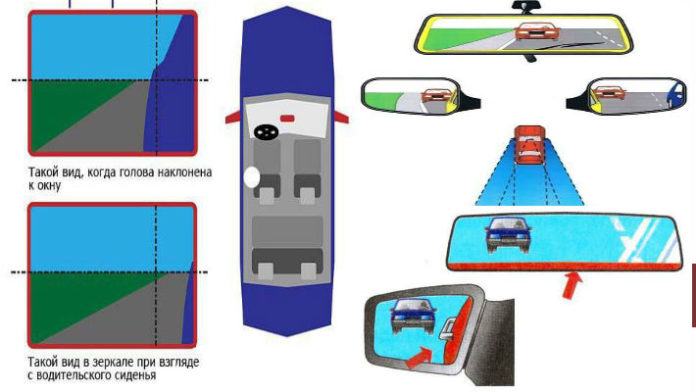
The rearview mirror is a mirror mounted on the vehicle and allows the driver to see what is happening behind. On cars and motorcycles, the presence of rear-view mirrors is mandatory. On modern cars, usually installed three rear-view mirrors: one in the cabin above the windshield, and two outside on the front doors - left and right.
If you, looking in the side mirror, see the rear wing of your car, it means that the mirror is configured incorrectly. Rearview mirrors are designed to provide a view of the road behind and to the side of the vehicle. They are one of the main parts of the car responsible for safety. Properly adjust the rear-view mirror is very important, because this largely depends on the safety of driving. Adjusted mirrors provide maximum circular visibility for the driver.
If you look in the side mirror, you see the rear wing of your car, it means that the mirror is set up incorrectly. With this arrangement of the mirror, most of the area behind the car can be seen in the side mirrors and in the rear-view mirror. At the same time, the area near the car is seen very badly and the danger of an emergency is created.
Adjusting the left side mirror
Leave to the left so that you practically touch the side window. Adjust the mirror so that you see the rear wing of the car (as shown in the picture). When you habitually settle down in an armchair, in a mirror you practically will not see a lateral wing of the car.
Adjusting the right side mirror
Leave to the right so that your head is in the center of the car. In the mirror, you should also see the rear wing of the car (see picture).
Rearview mirror adjustment
The center of the rear-view mirror should be in the center of the rear window.
Test Drive
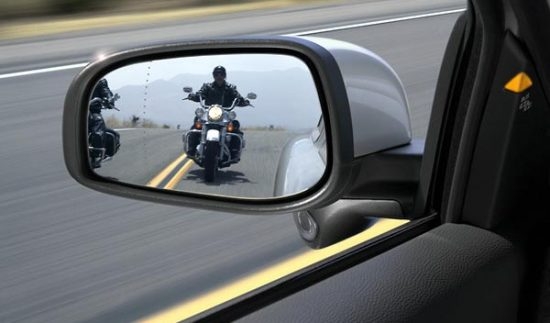
Rolling around with mirrors so tuned up, you'll notice that the "blind" zones have become much smaller. You see the car in the rearview mirror, and if it starts to overtake you, you still see a part of it in the rear mirror, and a part is already in the side. Due to this, it is easier for you to rebuild from one series to another, and the danger of an emergency situation is significantly reduced.
Some useful tips:
- The first time you will be very unaccustomed to ride with mirrors that are built in this way. But wait a week and you will get used so much that you will not understand how you used to go differently before.
- Be careful with parallel parking. With such an alignment of the mirrors, you need to turn your head and deviate to see both the side of your car and the car next to you.
- Always look in the mirror, not just the moment you want to change. Such a manner will allow you to constantly be aware of the situation on the road and in correctly performing sudden unforeseen maneuvers (for example, when you are driving around a pit).
A few important warnings:
- Do not adjust the mirror while driving.
- Even in properly tuned mirrors there are blind areas. And sometimes it's better to throw a quick glance over your shoulder when maneuvering, so as not to bring down, for example, a bicyclist or a motorcyclist. A look over your shoulder gives you the necessary information that you will never get, even looking at the properly adjusted mirrors.
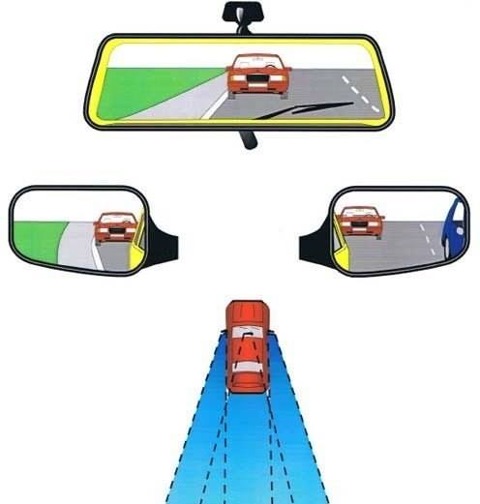

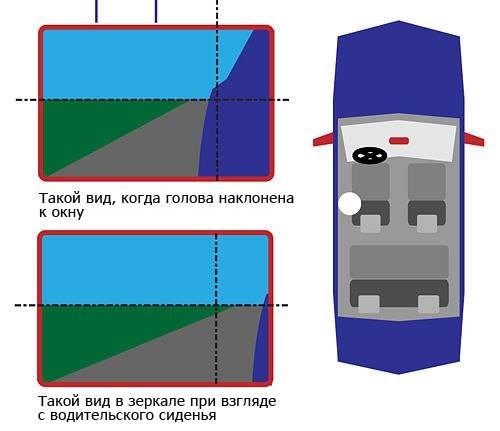

Mirrors of a rear view of cars
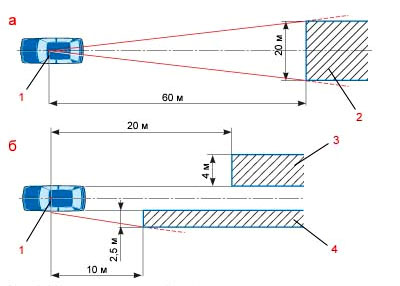
Minimum viewing areas through rear-view mirrors:
A - a view through the inside mirror, b - a view through the exterior mirrors;
1- the driver's eyes, 2- the minimum viewing area through the inside mirror, 3- the minimum viewing area through the right mirror, 4- the minimum viewing area through the left mirror.
Requirements for visibility:
- Through them, sketchy sections of an even horizontal road must be viewed up to the horizon line;
- The design of the mirror should provide a clear reflection when vibrating the car on road irregularities;
- Do not distort the shape and color of objects, capable of misleading the driver.
Mirrors must provide trauma safety:
- Exclude sharp edges on the body and bracket;
- Outside mirrors in the working position can not support the maximum dimensions of the car or the towed trailer by more than 200 mm, and their bodies must be folded, for example if the moving car is touched by a pedestrian mirror;
- The inside mirror is fixed in such a way that in the event of a head or driver's impact, it does not harm them, but folds or breaks off at the base of the bracket;
- When breaking a mirror, the formation of fragments that can injure a person is excluded.
Most car mirrors, both internal and external, consist of:
- Optical element,
- Body, bracket
- Adjustment mechanism.
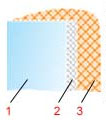
Optical element with an optical reflective layer: 1-plane-parallel glass, 2-sprayed reflective layer, 3- protective varnish.
An optical element is a mirror part reflecting light and forming a reflected image, there are:
- Flat (flat gives a minimum viewing angle, but does not distort the distance to objects)
- Spherical (provides a larger angle, reducing the "dead zones", but somewhat distorts (visually increases) the distance and shape of objects.The minimum allowable radius of curvature (the largest convexity) of car mirrors is 1200 mm .The right exterior mirror can provide the required overview only if Is spherical)
- Spherical (multisectional) optical elements (spherical combines two or more reflecting surfaces, the main one is flat or spherical of small curvature) Auxiliary (one or more) spherical with greater curvature or cylindrical)
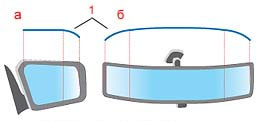
Spherical mirrors: a is a mirror with a flat and cylindrical surface, b is a mirror with three spherical surfaces of different curvature. 1- profiles of reflecting surfaces.
Adjustment of most interior and most simple external mirrors, in which the optical element is stationary relative to the body, is carried out by turning them on a single hinge. More complex exterior mirror designs allow the optical element to rotate relative to the body using a hinge system. Most mirrors of this type are equipped with a remote adjustment drive. The drive is lever, cable or electric. In the first two cases, the control is located inside the cabin at the place where the mirror is fastened to the door or in another convenient place on the door skin. The electric drive of the external mirror has two electric motors located in its housing, which rotate the optical element in the vertical and horizontal planes. The drive is controlled by a switch ("right - left mirror") and a key that activates the motors. Typically, the switch and key are combined in one unit located on the door, dashboard or on the center console.
Such different mirrors
And it all began, of course, with a woman. Well, who else could suggest using a mirror in the car? In the far 1906, Dorothy Levitt's book "Woman and Car" was published, containing many useful tips for ladies who mastered this new outlandish vehicle. Among them was the advice to keep a mirror with a handle for a rear view while driving. The idea did not take root right away: in those distant times street traffic was not too tense, so there was no need for ordinary drivers to look back and on the sides for the time being. Another thing is the race - here Mrs. Levitt's advice was very welcome. In 1911 racer Ray Harron, unable to find a suitable mechanic (whose duties included accompanying the rider on the road and navigational functions during the competition), adapted the mirror to his Marmon car, which allowed him to win the main prize of the Indianapolis 500 race .
After that, engineers of the automotive industry suddenly remembered - a year after the triumph of Harron Elmer Berger patented the design of the first rear-view mirror, which was used on production cars. Since then, mirrors have become a constant attribute not only of cars, but also of motorcycles, mopeds and even bicycles.
In our time, cars usually have three mirrors - two side mirrors and one salon. However, this was not always the case. Previously, drivers were content only with a salon mirror. In the 1950s, the cars were equipped with a lateral left, and later with a right-hand side mirror.
Far from the driver's side mirror is sometimes performed slightly convex, which allows you to increase the viewing angle. For this, however, it is necessary to pay the distortion of distances to objects that are reflected in the mirror. In addition, the side mirror can additionally have a circular convex insert, further increasing the visibility. In the cabin, a convex so-called panoramic mirror is sometimes installed, which gives a wide-angle rear "picture", also, however, distorted, which can adversely affect traffic safety.
In addition to the three main mirrors, cars can be equipped with auxiliary mirrors - the outer rear, side to control the right size. Most often this applies to trucks, vans and minivans. Such mirrors are designed to help with maneuvering, backing and parking.
In the 50s in America they found a new place for rear-view mirrors - the front wings of the car. True, this design in the world car industry did not take root.
Side mirrors in the vast majority of cases are installed on the front doors of the car, but many motorists remember and another scheme for installing mirrors - on the front wings. This scheme was born in the 50 years in the US, but lasted for a relatively short time - it was very uncomfortable to adjust the mirrors, and in aesthetics the car did not add. There were pluses - the lack of so-called "dead zones" and finding a mirror in one field of vision with the road.
For the longest time, this scheme remained true in Japan - on our roads, models of the 80-90s with mirrors on wings still go.
Modern exterior mirrors are high-tech products equipped with various electronic systems. Heated and electrically adjustable mirrors are few people you will be surprised. Now the mirrors can be independently adjusted for a particular driver (memory function), and automatically darken to prevent the driver from becoming dazzled, and warn about the presence of another car in the "dead zone" when rebuilding.
Despite the fact that in modern models to get information about what is happening behind the car, they begin to use video cameras, the traditional mirror will for a long time be the most reliable and trouble-free means of rearview. Still, people still trust their eyes more than the most perfect electronics.
How and how to adjust the mirrors in the car
The main task of adjusting the rear view mirrors is to obtain the most complete and convenient image, and also to minimize the "dead zones". A "dead" or "blind" zone is a section of a road near a car that can not be seen with mirrors. The adjustment of the side mirrors was previously performed either manually outside the car (now such an anachronism as the hinged mechanism for adjusting the mirrors remained, perhaps, only with the utilitarian Land Rover Defender), or with the help of levers from inside the cabin.
On modern cars, usually used joystick, which allows you to conveniently manage the mirrors using an electric drive. The most advanced control systems adapt the position of the mirror depending on the driving mode (for example, when reversing).


Comments
When commenting on, remember that the content and tone of your message can hurt the feelings of real people, show respect and tolerance to your interlocutors even if you do not share their opinion, your behavior in the conditions of freedom of expression and anonymity provided by the Internet, changes Not only virtual, but also the real world. All comments are hidden from the index, spam is controlled.